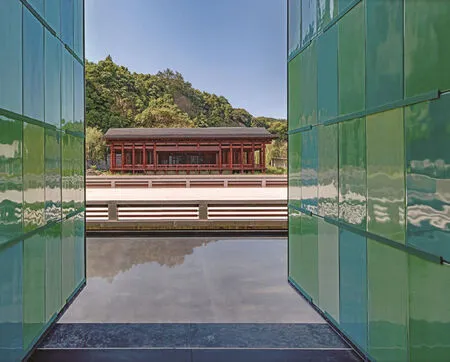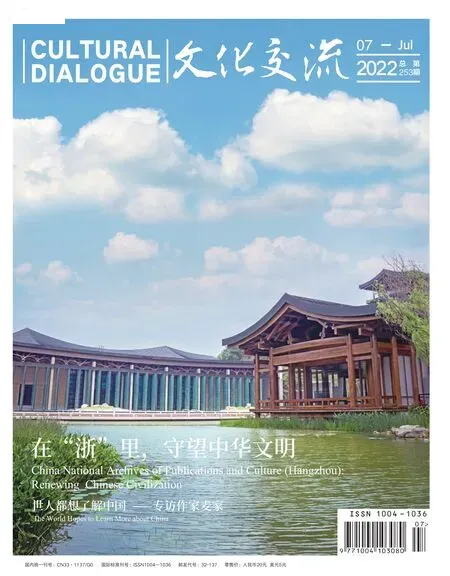版本传承 文明赓续
这些日子,一直有个问题萦绕心头:版本对于中华文明的传承与发展到底意味着什么?本期视点我们与读者一同走进杭州国家版本馆,一起找寻答案。
什么是版本?版本最初指一种书籍经过多次传抄、刻印或以其他方式而形成的各种不同本子。随着时代的发展,版本也开始应用于影视、软件等。
翻开中国以及浙江版本历史,我们可以清晰地看到,中国是世界上最爱读书和藏书的国家之一。据史料记载,中国各地曾有过数以千计的藏书楼。自宋代以来,浙江的藏书家至少有850人之多,而历代所建的藏书楼更是多达800余座,居全国榜首。沧海桑田,目前,浙江留存于世的传统藏书楼仅11座,而全国也不过100余座。在这些藏书楼中,以位于杭州市西湖区孤山路25号,即孤山南麓浙江省博物馆内的“文澜阁”最负盛名,“文澜阁”为清代乾隆年间为珍藏《四库全书》而建造的全国七大书阁之一。
杭州国家版本馆落成和开馆对于中华文化安全与文化复兴意义重大。
杭州国家版本馆取名“文润阁”,从名称上就可以看出这是对“文澜阁”的继承。当然,“文润阁”不是传统意义上的“文澜阁”,它是集展览馆、图书馆、档案馆、博物馆等多种功能形态于一体的综合性场馆。它既是国家从文化安全和文化复兴的战略考量出发作出的重大部署,又是中外文明交流互鉴的重要窗口,也是文脉赓续的传世工程。
版本馆承载着中华文化的基因和血脉,是不可再生、不可替代的中华优秀文明资源,是营造传承中华文明的浓厚社会氛围的有力见证。版本馆建成并正式开馆,将更加广泛地宣传中华版本文明的研究成果,教育引导大众特别是青少年更好地认识和认同中华文明,增强做中国人的志气、骨气、底气。
本期视点中,我们特别关注了7位为版本馆征集工作作出贡献的海内外友好人士。如怀着一片赤诚之心回归祖国的老华侨周添成;为促进中美民间友谊奔走二十多年的潘杰和范祝华夫妇;从青春年少时开始学中文,五十多年来一直热爱中华文化的德国汉语学家许瀚为;致力于中国公共卫生事业三十六年的英国专家何丽莎;为促进中日艺术文化交流殚精竭虑三十年的浙江籍旅日书法篆刻艺术家晋鸥;把几乎是毕生珍藏全部捐出的九旬电影人张理竺。

TO GET HER FOR A SHARE DFU TRUE杭州国家版本馆。肖奕叁/摄China National Archives of Publications and Culture (Hangzhou). Photo by Xiao Yisan.
Carry Forward the Chinese Civilization through Archives and Publications
These days, a couple of questions have been on our minds. What is an“edition”? What do the inheritance of and research on editions mean for the development of Chinese civilization — past, present and future? We’re trying to find out the answers in this issue in the newly opened China National Archives of Publications and Culture (Hangzhou).
In its original sense, editions refer to the various versions of a book that has been copied, printed, or otherwise reproduced. Gradually, the concept of editions also begin to be applied to movies, software and other things that take the same subject but show it in different formats.
The opening of the China National Archives of Publications and Culture (Hangzhou) will be of great significance to the security and rejuvenation of the Chinese culture.
If we look at the “edition history” of China and Zhejiang, we can clearly see that China is among the countries that love reading and collecting books the most. Historical records show that China used to have thousands of(literally “book collecting building”). Since the Song dynasty, at least 850 well-known book collectors have been from Zhejiang, and more than 800were built over the generations,the most in China. However, only 11in the traditional sense remain in Zhejiang and only some 100 remain in China. Among them,Wenlan Ge or the Wenlan Pavilion (also known as the Imperial Wenlan Library and the Imperial Library) in Hangzhou is the most famous, built during the reign of Emperor Qianlong as one of the seven libraries for the collection ofor the.
Indeed, the China National Archives of Publications and Culture(Hangzhou), known as “Wenrun Ge” (or Wenrun Pavilion), is to a large extent a continuation of Wenlan Ge.
On the other hand, Wenrun Ge is far more than a traditional; it is a complex that has incorporated exhibition halls,libraries, archives and museums, among others.
For this issue’s “Special Feature”, we focus on seven people who have donated to Wenrun Ge. Zhou Tiancheng, an overseas Chinese and a true patriot; Pan Jie and Fan Zhuhua, a couple who have helped promote exchanges between China and the US; Hans-Wilm Schütte, a German Sinologist and a cultural ambassador; Therese Hesketh, a British lady whose love for Hangzhou is immense; Jin Ou, a Zhejiang native and a seal engraving artist who has lived in Japan for 30 years; and Zhang Lizhu, a nonagenarian and film veteran who has donated all his collections.

